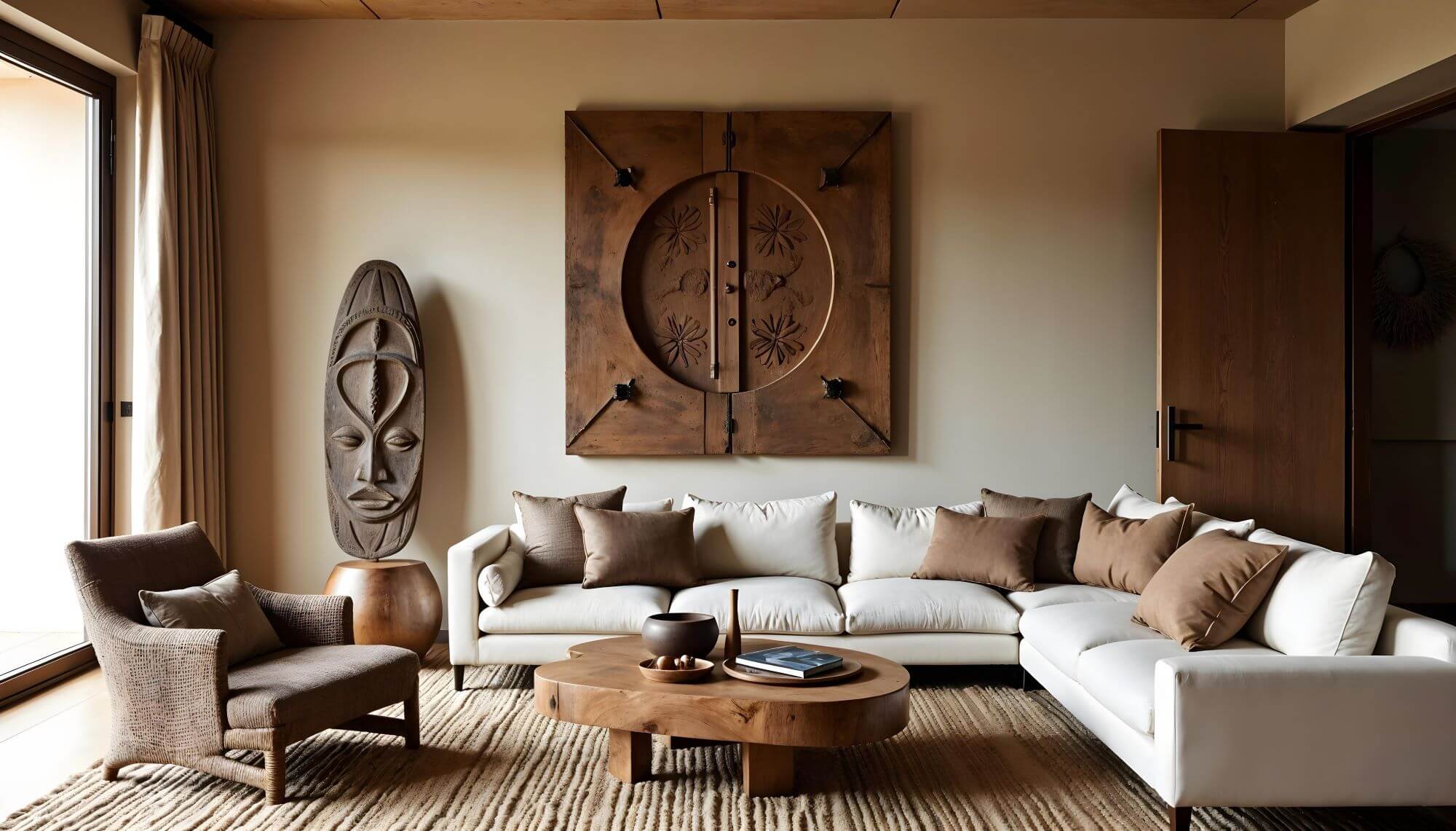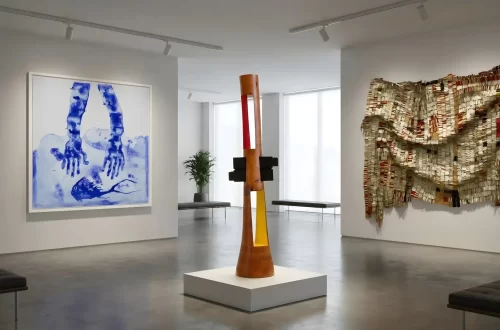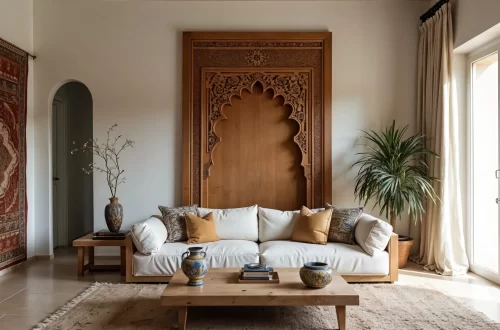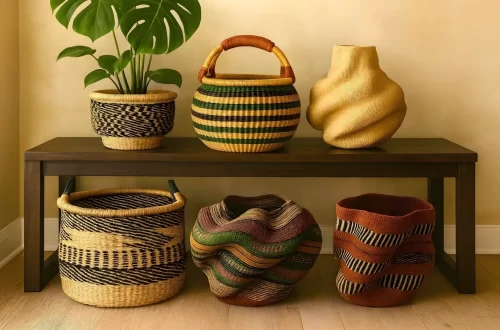Steeped in history and rich with meaning, traditional African art goes beyond visual appeal—it’s a doorway to the stories, beliefs, and creativity of its makers. From Ghana’s Akuaba dolls to Benin’s Bronze Heads, Africa is home to timeless treasures that belong at the center of the world’s art stage. In this article, we’ll uncover the history behind five striking works and share tips to seamlessly style them in your home. Whether you’re a collector or simply looking for meaningful decor, these art pieces are sure to inspire.
Why These 5 Traditional African Art Pieces Are Worth Your Attention
- Akuaba Dolls, Ghana: Guardians of Fertility
- Dogon Doors of Mali: Gates to Sacred Traditional African Art
- Tonga Stools, Zimbabwe: Seats of Authority and Style
- Punu Masks, Gabon: Idealized Beauty with a Spiritual Touch
- Bronze Heads: Regal Tributes from the Kingdom of Benin
Akuaba Dolls, Ghana: Guardians of Fertility
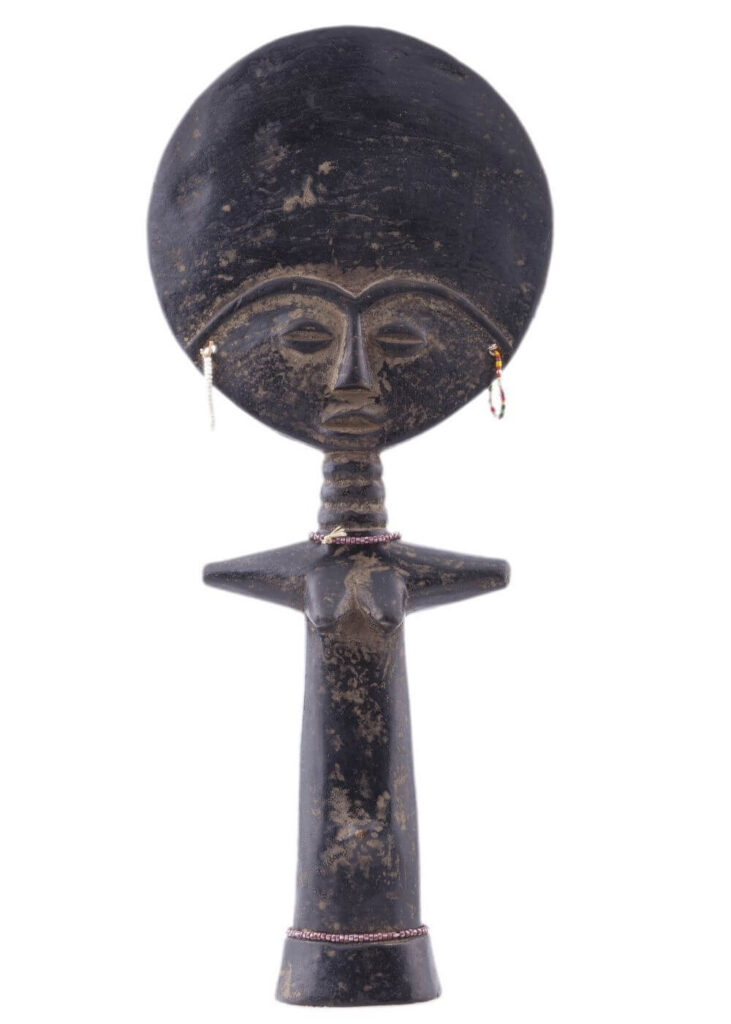
Akuaba dolls were created by the Akan people of Western Ghana, particularly associated with the Ashanti (Asante) and Fanti (Fante) communities. These dolls hold a special place in Akan culture, representing fertility and motherhood in a way that goes far beyond mere decoration.
According to legend, a woman named Akua sought help on her journey to motherhood and turned to a spiritual healer. The healer commissioned a doll for her, instructing her to care for it as though it were her child. And her dedication worked—she eventually gave birth to a healthy baby. Since then, these dolls have been called “Akua’ba,” meaning “Child of Akua.”
Every detail of an Akuaba doll carries meaning. The ringed neck and prominent breasts represent fertility, while the large head symbolizes a newborn. Even the protruding navel reflects the profound connection between mother and child. Beyond their symbolic beauty, Akuaba dolls remain talismans of hope, with some women still embracing them as sacred charms today.
How to Style an Akuaba Doll in Your Home
The Akuaba doll is a versatile traditional African art piece that adds intrigue to your space. Try placing it on a console table in the entryway, paired with other decor items for an inviting first impression. It also shines as part of a curated display on a wall shelf in your living room or library. This way, its unique shape and symbols can be admired up close.
Dogon Doors of Mali: Gates to Sacred Traditional African Art

For the Dogon people of Mali, a door is far more than just an entrance—it’s a spiritual threshold. These intricately carved wooden doors are seen as protectors against evil and storytellers of the Dogon’s spiritual beliefs.
Decorated with ancestral figures and symbols like the sun, moon, stars, and animals, the designs on Dogon doors reflect a connection between the cosmic and the earthly, embodying powerful legends and tales. They have become a renowned traditional African art form.
But Dogon doors aren’t just spiritual—they’re practical, too! Their size and decoration often signal the wealth and status of the household they protect. To own one is a matter of pride, as these beautifully crafted doors don’t just protect homes—they also preserve centuries of tradition and culture.
How to Style a Dogon Door in Your Home
A Dogon door can elevate almost any area in your home. Smaller ones work well as part of a decor display on a console or a shelf. Medium-sized doors can be propped up on a table against a wall or even hung directly—it’s especially striking on a side wall rather than a large central one. And if you’re the lucky owner of a large Dogon door, then let it stand on the floor. It can be leaning against the wall for a dramatic touch in a seating area or entryway.
Tonga Stools, Zimbabwe: Seats of Authority and Style
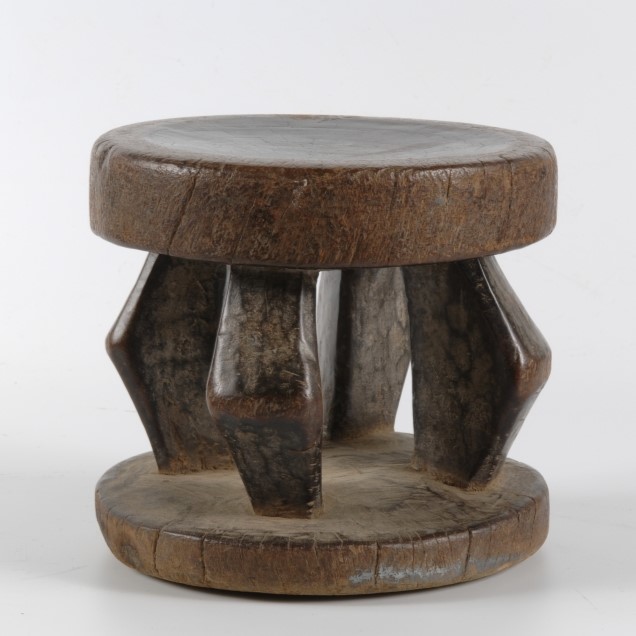
The Tonga stools of Zimbabwe are anything but ordinary furniture—they’re symbols of status, tradition, and portability. Initially reserved for elders and heads of households, these stools were powerful markers of authority within the Tonga community.
Tonga stools were designed with nomadic lifestyles in mind: they are lightweight and easy to transport, making them the perfect travel companion. Whether attending weddings, funerals, or other gatherings, the Tonga people would carry these stools from village to village.
Crafted from a single piece of hardwood, each stool is a testament to the Tonga’s craftsmanship. Today, it has become a design icon—beloved not only in African homes but around the world. Whether at a traditional ceremony or in a modern living room, this traditional African art piece carries the spirit of its people wherever it goes.
How to Style a Tonga Stool in Your Home
The iconic Tonga stool brings understated elegance to both living rooms and bedrooms. In the living room, try placing it next to the couch, by the coffee table, or between two armchairs. For the bedroom, it works beautifully next to a chair or ottoman. Either way, if you want to make a statement, set it on a luxurious African rug to highlight its craftsmanship. Finally, if you have a smaller stool, consider placing it on a console table—it adds height and depth to any decor arrangement.
Punu Masks, Gabon: Idealized Beauty with a Spiritual Touch
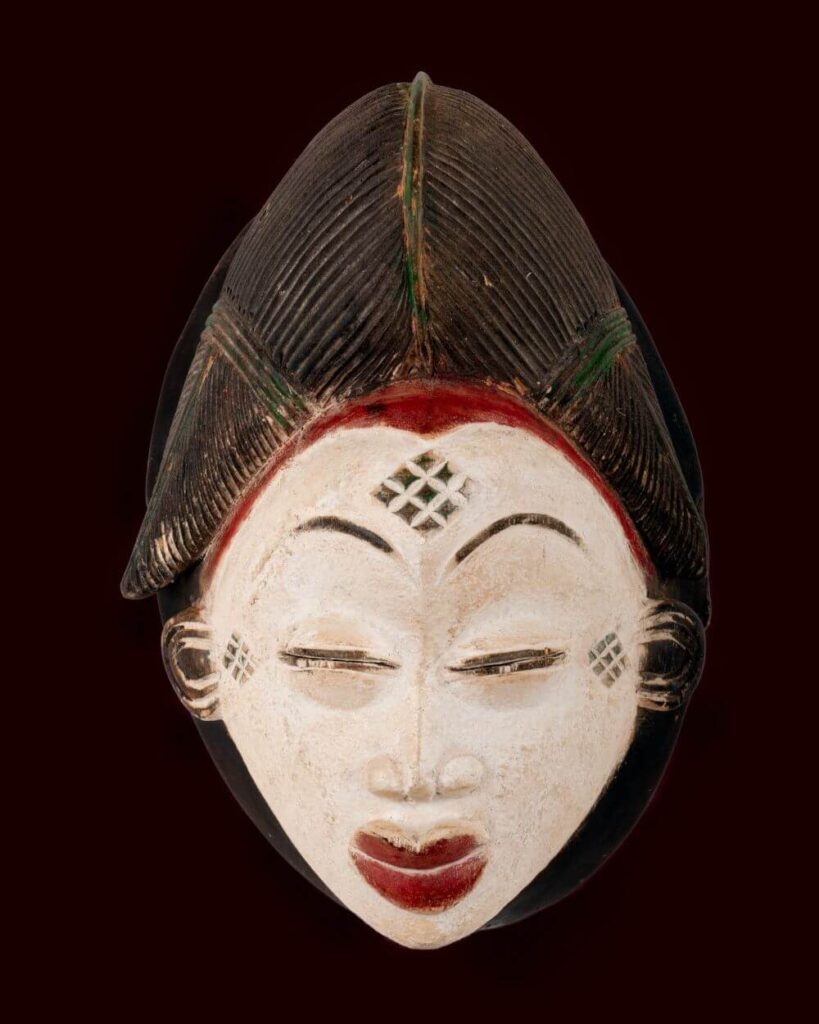
The Punu people of Gabon are known for crafting elegant masks that have become iconic in traditional African art. These masks represent the idealized beauty of Punu women and are carefully carved by men, reflecting a society that holds cultural aesthetics in the highest regard.
The high-domed hairstyles featured on the masks are a symbol of wealth and status, reserved for women who could afford elaborate styles. These women, free from the burden of carrying everyday goods on their heads, could showcase their wealth through their appearance.
Some Punu masks are painted white with kaolin clay, symbolizing the spirits of ancestors. Often worn during funerals, these masks serve as both a tribute and a bridge between the living and the spiritual world. With serene expressions and diamond-shaped scarifications on their foreheads, they are breathtaking symbols of the Punu’s heritage.
You May Also Like: Traditional African Masks: 7 Icons That Steal the Spotlight
How to Style a Punu Mask in Your Home
A Punu mask feels right at home in spaces like a library or home office—rooms steeped in knowledge and culture. It also looks stunning in a formal living room, where its graceful lines and serene expression can truly shine. This is a piece that deserves attention, so display it on a base or stand, letting it take center stage in your decor.
Bronze Heads: Regal Tributes from the Kingdom of Benin
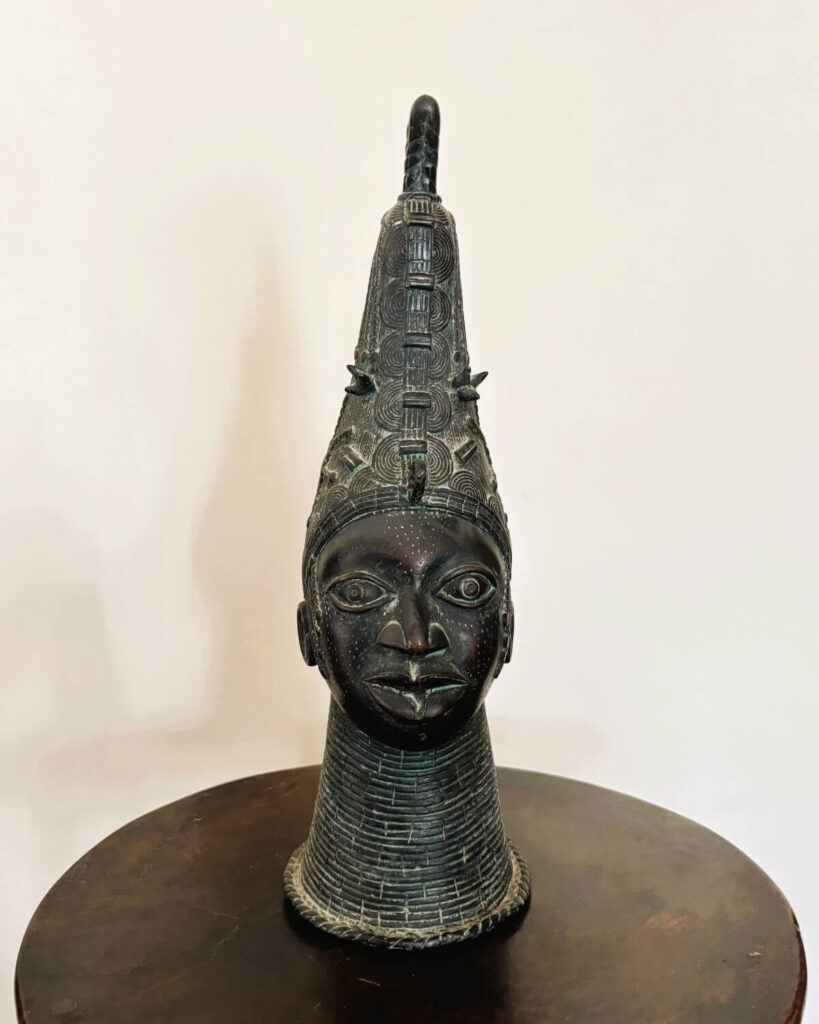
The Bronze Heads of Benin, originally crafted by the Edo people, radiate power and reverence. These regal sculptures were first created to honor a former oba (king), serving as a shrine to preserve the ruler’s legacy. Beyond their spiritual significance, they were also presented as gifts to dignitaries, expanding their influence far beyond the borders of Benin.
What makes these Bronze Heads even more fascinating is their patina—a greenish hue that develops over time. Not only does this patina protect the bronze, but it also adds to the sculptures’ mystique, making each piece uniquely beautiful. Through these masterpieces, the legacy of Benin’s rulers endures, uniting history, craftsmanship, and storytelling. They have become an important symbol of traditional African art in West Africa, continuing to captivate and inspire today.
How to Style a Bronze Head in Your Home
For a regal touch, place a Bronze Head on a console table in your entryway or formal living room—it’s a striking way to welcome guests. Another option is to highlight it in a wall niche, where its intricate details can be appreciated. Either way, this piece is all about commanding attention—creating a striking focal point wherever it’s placed.
Traditional African art isn’t just something to admire—it’s something to experience.
The sacred meaning of a Dogon door and graceful air of a Punu Mask bring a unique sense of power to your home. These works carry the soul of Africa and can transform a space from ordinary to extraordinary. By adding them to your home, you’re not just displaying art; you’re carrying a heritage and bringing the heartbeat of African culture into your everyday life.
Interested in African art? Discover 3 Famous West African Masks with Great Purchase Options.

